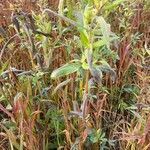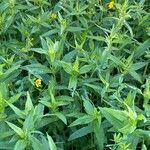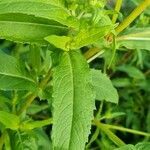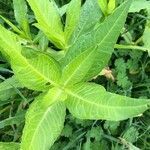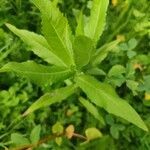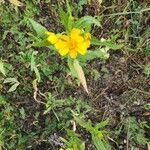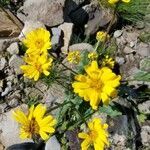Annual herb (0.3–) 1–2 m high, ± glabrous to hairy; stems to 10 (–15) mm diam. Leaves narrowly ovate to obovate, (45–) 60–200 mm long, (10–) 20–50 mm wide, mostly toothed, rarely entire, stem-clasping. Capitula long-pedunculate, few to many, 10–15 mm diam. excluding rays, 15–25 (–40) mm diam. including rays; involucral bracts sparsely and minutely hairy; outer bracts 5 or 6, broadly ovate, cochleate or cucullate, rarely lanceolate, erect and enclosing inner bracts; inner bracts obovate, white with longitudinal purple stripes. Ray florets yellow; ligules elliptic, 11–15 mm long. Achenes 4–6 mm long, brown or black (silvery grey when immature).
Annual herb 1–2 m high, erect; stems often purplish, pilose to glabrous.. Leaves sessile, subconnate-perfoliate, lanceolate to oblanceolate, 10–15 cm long, 2–6 cm wide, base truncate to cordate, margins entire to serrate, apex acute, scabrid on both surfaces, with sessile glands.. Capitula in terminal few-headed cymes; stalks of individual capitula 2–12 cm long; involucre 7–10(–32) mm long, the outer phyllaries foliaceous, pilose, the inner scarious; paleae 5–9 mm long, 5-veined.. Ray florets yellow, 6–8(–15), tube 1–2.8 mm long, ray 8–14(–21) mm long; disc florets many, yellow, 4–5.5 mm long.. Achenes 3.5–5.7 mm long; pappus absent.
Annual herb 1-2 m high, erect; stems often purplish, pilose to glabrous. Leaves sessile, subconnate-perfoliate, lanceolate to oblanceolate, 10-15 cm long, 2-6 cm wide, base truncate to cordate, margins entire to serrate, apex acute, scabrid on both surfaces, with sessile glands. Capitula in terminal few-headed cymes; stalks of individual capitula 2-12 cm long; involucre 7-10(-32) mm long, the outer phyllaries foliaceous, pilose, the inner scarious; paleae 5-9 mm long, 5-veined. Ray florets yellow, 6-8(-15), tube 1.0-2.8 mm long, ray 8-14(-21) mm long; disc florets many, yellow, 4.0-5.5 mm long. Achenes 3.5-5.7 mm long; pappus absent.
An erect branched herb. It grows 30-180 cm tall. The stems are soft and hairy. The leaves are usually carried opposite one another. The leaves do not have stalks and they clasp the stem. The leaves have teeth along the edge and the surface is a little rough. The flower head is made up of many small flowers each capable of producing a seed. The fruit (called seeds) are black angled structures. They are up to 12 mm long. The seed inside is 3.5-5 mm long. There are about 250-300 seeds per gram.
Scabrous or subglabrous annual to 1 m; lvs sessile and clasping, lance-oblong, acuminate, serrate, to 10 × 3 cm; heads several or many, the disk 1.5 cm wide; outer invol bracts ca 5, ovate or obovate; rays 8–13, broad, 1.5–2 cm; 2n=30. Native of trop. Afr., occasionally adventive in waste places in our range. Sept., Oct.
Annual herb, up to 2 m high. Leaves oblong-lanceolate, serrate to subentire, sessile, amplexicaul, glandular hairy. Pappus absent. Flowers yellow.
Receptacular paleae 5–7+ mm. Ray corolla laminae 8–14+ mm. Disc corollas 4–5 mm. Cypselae 4–5 mm. 2n = 30 (from India).
Numerous heads of bright yellow flowers 1-11/2 in. across.
A nearly glabrous shrubby herb up to about 4 ft. high
